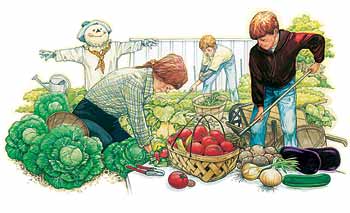
Growing Through Gardening
By Richard Romney
Illustration by Joel Snyder
Cultivating a garden, whether downtown or in the country, can be a fun learning experience for the whole family.
Ask the Randy and Brenda Ririe family which vegetables they grow, and their first response will be "potatoes." That's because, right now, their 300-acre farm outside Basin City, Wash., includes acres of them, plus lots of other vegetables. But in addition to these fields of crops for market, they also have a 25-by-25-foot vegetable garden just for the family.

Ask the Scott and Laurie England family which vegetables they grow, and they'll take you to the backyard of their suburban home in East Mill Creek, Utah. There, between the lawn and the fence, Laurie will show you a well-organized 20-by-50-foot garden, complete with a drip irrigation system and a compost bin.
A bountiful harvest
Both of these couples have something besides gardens in common—they have children, too. Their two older children are grown, but the Riries still have a 14-year-old and 9-year-old at home. The Englands have four children from ages 8 to 14.
In both families, the children will tell you that they have learned more than gardening skills by helping with their family's garden.
"We've learned about teamwork," says Stephanie Ririe, 14, "because a couple of us working together can get a lot more done than one person working alone. When there are two of us, we can make it fun."
Whitney England, 13, says she has learned the value of listening to instructions. "My mom really knows about gardening," she says. "So when she tells us what to do, we know we need to do it."
Laurie England says she goes out of her way not to demand too much. "Gardening is what I love," she explains, "so I want it to be fun for the children, not overwhelming." While she and Scott do the heavy work, "we have the children help with the planting, some of the weeding and hoeing, and with the harvesting—things where they can see immediate results."
What's in your garden?
If you were asked which vegetables you were growing and your answer was "none," perhaps you might want to reconsider.
Both the Riries and the Englands have found that growing a garden can be a great family activity. The good news is that there's plenty of help available for would-be family gardeners. And even if you live "in a house or apartment with only a balcony, patio, or roof area for gardening," as the publication Gardening in Containers (Ortho Books, 1997) puts it, "you can develop your horticultural skills and please your palate with an edible garden in containers."
It is impossible to list everything about getting started in gardening in a short article, but here are few tips. (See a list of additional resources in the sidebar.)
Grow at your own speed.
There's some truth to the joke that even if you don't know beans about gardening, you can always grow tomatoes and zucchini. Simply put, certain vegetables thrive more easily than others.
"We've found that some of the most reliable crops are…beets, chard, cucumbers, green beans, leaf lettuce, parsley, peppers, radishes, summer squash, and tomatoes," writes co-author Michael MacCaskey in Gardening for Dummies (Dimensions, 1999).
It's a good strategy to start with plants like those first to learn what you're doing. If you've never had a garden, you and your children may be perfectly happy growing a couple of cucumber vines and two or three tomato plants. Then, when you have confidence, try something new.
Plan for a day in the sun.
Vegetables grow best in an area where they can get six to eight hours of direct sun. In Gardening for Dummies, Michael MacCaskey recommends running rows of vegetables east to west, with the tallest plants on the north end. If your apartment has no balcony, you may still be able to use a "grow light" to raise a few plants indoors.
Start small; grow tall.
Even buckets on a porch can produce quite a bit of produce. However, a 12-by-16-foot plot can provide more variety, while a 20-by-20-foot garden accommodates plants that need extra space, like winter squash and corn. Three-foot-wide plant beds separated by 18-inch paths are about right.
There are many techniques for building raised plant beds. Laurie England likes to leave the pathways in her garden untilled and unwatered, which reduces work and weeding. Some plants will grow on trellises or poles, and with a little help they can be trained to grow vertically.
Avoid too much water.
A common gardening problem is overwatering. Tomatoes, in particular, don't respond well to being "drowned." Your plants will do best if the soil drains well. Once the vegetables are established—unless the weather is really hot—you may only need to water deeply once or twice a week.
Think things through.
Many tasks in gardening are easier if you do them at the right time or regularly. For example, fall is the best time to break new ground and enrich soil for spring planting. That way, organic soil enrichers like compost, manure, and peat moss have time to blend in over the winter.
Weeding and fertilizing, like watering, are best managed with a schedule. Be wise in using insecticides—many require a waiting period before you can safely eat treated food.
Also remember to accommodate the growing season. Plant too early, and you may lose vegetables to frost. Plant too late, and you may not have time to harvest before winter. Where growing seasons are short, start seedlings indoors or buy them from a nursery. In warmer climates, plan for two or more growing seasons in a year.
Show you care—and share.
Both the Riries and the Englands say that if you grow your garden as a family activity, your kids will eat it up. Let them pick which vegetables they'd like to eat. Remind them during dinner that they helped grow what's in their soup or salad.
Plant fun plants—like cherry tomatoes or strawberries—that they can eat for a healthy after-school snack. Enter what you've grown in the county fair. Make that gigantic zucchini into zucchini bread and take it—as a family—to the neighbors. If you have lots of extra vegetables, share them around as well, or take them to a food bank.
If you and your family invest the time and energy, it may soon be the case that no one will have to ask you which vegetables you grow. You will have already told them all about it.
Richard M. Romney writes from Salt Lake City.
How To Get GrowingThere are lots of places to get gardening advice; here are a few suggestions:
Neighbors and friends.
Books. My Backyard Garden (William Morrow & Company, 1998) by Carol Lerner is a step-by-step guide for beginners. GrowLab, published by the National Gardening Association; Kids Garden! The Anytime, Anyplace Guide to Sowing & Growing Fun (Williamson Kids Can! Series, Williamson Publishing, 2003) by Avery Hart and Paul Mantell; and the New Junior Garden Book by Felder Rushing (Better Homes and Gardens, 1999) each has a bumper crop of step-by-step projects for children. Gardening in Containers, from Ortho Books (1997), has excellent information for those who "live in a house or apartment with only a balcony, patio, or roof area for gardening."
Agricultural extension services. They provide literature, classes, and analysis of soil, plants, and insects. Contact the university directly or look for an "agricultural extension services" listing in the state or county government pages in your phone book. Many counties have agricultural agents, and many extension offices have Web sites, such as www.extension.umn.edu, www.uwex.edu, www.ces.ncsu.edu, www.ag.uiuc.edu, www.ext.nodak.edu, www.ianr.unl.edu, and www.ag.ohio-state.edu.
Seed packets and catalogs.
Other Web sites. —R.R. |
January - February 2004 Table of Contents
Copyright © 2004 by the Boy Scouts of America. All rights thereunder reserved; anything appearing in Scouting magazine or on its Web site may not be reprinted either wholly or in part without written permission. Because of freedom given authors, opinions may not reflect official concurrence.